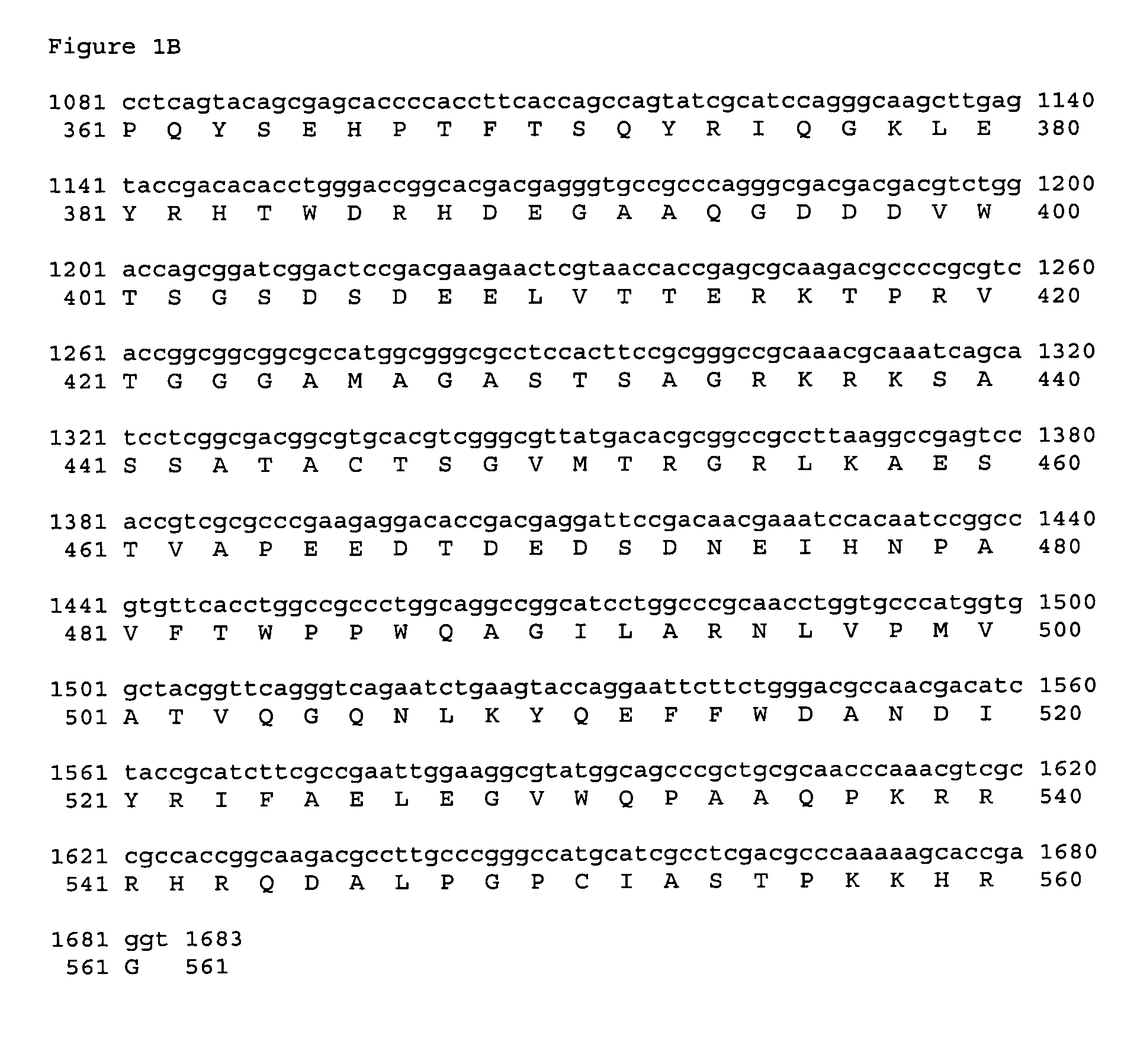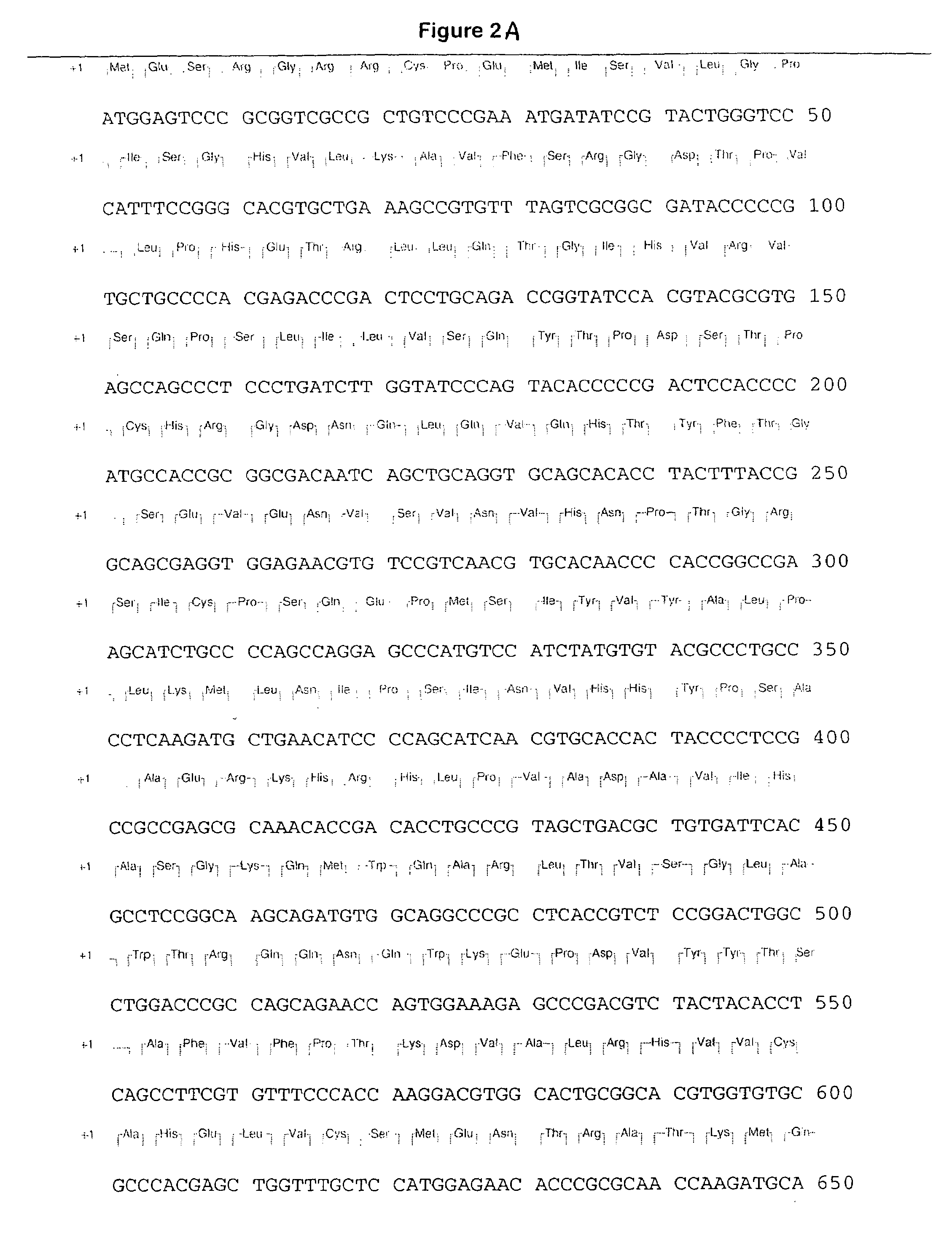Codon-optimized polynucleotide-based vaccines against human cytomegalovirus infection
a technology of cytomegalovirus and cytomegalovirus, which is applied in the direction of immunological disorders, drug compositions, peptides, etc., can solve the problems of hcmv-associated disease remains severely debilitating and life-threatening in hiv patients, colitis, colitis, etc., and achieves the effect of reducing the number of administrations and reducing the kinetics of immunological respons
- Summary
- Abstract
- Description
- Claims
- Application Information
AI Technical Summary
Benefits of technology
Problems solved by technology
Method used
Image
Examples
example 1
Construction of an Isolated Polynucleotide Comprising a Minimally Human Codon-Optimized pp65 Coding Region, Encoding Human Cytomegalovirus pp65 with Kinase Site Deleted
[0187]VCL-6368 encodes an optimized and mutated form of the human CMV antigen pp65 cloned into the expression vector VR10551 described supra. This plasmid encodes a 557 amino acid protein (SEQ ID NO:6) in which amino acids Arg435-Lys438 of the human CMV pp65 antigen have been deleted. The coding sequence was minimally optimized for expression in humans by changing five codons that are rarely used in humans to corresponding codons that are used more frequently. The five codons and changes are: Ala GCG to GCC, Arg CGT to CGC, Pro CCG to CCC, and CCA, Ser TCG to TCC, and Thr ACG to ACC. The optimized sequence is SEQ ID NO:5.
[0188]The pp65delArg435-Lys438 insert of VCL-6368 was constructed in two steps by PCR amplification of an optimized hCMV pp65 plasmid synthesized at Retrogen Inc. (San Diego). The TOPO-hCMV-opti-pp65 ...
example 2
Construction of an Isolated Polynucleotide Comprising a Minimally Human Codon-Optimized Glycoprotein B Coding Region, Encoding the Secreted Human Cytomegalovirus Glycoprotein B
[0190]VCL-6365 encodes a secreted form of the human CMV antigen gB cloned into the expression vector VR10551 described supra. This plasmid encodes amino acids 1-713 of the human CMV gB antigen (SEQ ID NO:14). Nucleotides 1-2139 of the wild-type gB coding sequence (SEQ ID NO:11) were minimally optimized for expression in humans by changing five codons that are rarely used in humans to five corresponding codons that are used more frequently. The five codons and changes are: Ala GCG to GCC, Arg CGT to CGC, Pro CCG to CCC, CCT, and CCA, Ser TCG to TCC, and Thr ACG to ACC. The optimized sequence is SEQ ID NO:13.
[0191]VR6365 was constructed by inserting a 2160 bp synthesized fragment encoding amino acids 1-713 of the human CMV gB antigen inserted into the expression vector VR-10551. Specifically, VR-10551 was digest...
example 3
Construction of an Isolated Polynucleotide Comprising a Human Codon-Optimized CMV IE1 Coding Region, Encoding Human Cytomegalovirus IE1
[0194]Plasmid VCL-6520 comprises a 1236 base-pair human codon-optimized synthetic DNA construct encoding exons 2 and 4 of the human CMV IE1 gene, inserted into the expression vector VR-10551. The wild type sequence for exons 2 and 4 of the human CMV IE1 gene follows (SEQ ID NO: 50):
[0195]
GAATTCGCCGCCACCATGGAGTCCTCTGCCAAGAGAAAGATGGACCCTGATAATCCTGACGAGGGCCCTTCCTCCAAGGTGCCACGGGTCAAACAGATTAAGGTTCGAGTGGACATGGTGCGGCATAGAATCAAGGAGCACATGCTGAAAAAATATACCCAGACGGAAGAGAAATTCACTGGCGCCTTTAATATGATGGGAGGATGTTTGCAGAATGCCTTAGATATCTTAGATAAGGTTCATGAGCCTTTCGAGGAGATGAAGTGTATTGGGCTAACTATGCAGAGCATGTATGAGAACTACATTGTACCTGAGGATAAGCGGGAGATGTGGATGGCTTGTATTGATGAACTTAGGAGAAAGATGATGTATATGTGCTACAGGAATATAGAGTTCTTTACCAAGAACTCAGCCTTCCCTAAGACCACCAATGGCTGCAGTCAGGCCATGGCGGCACTGCAGAACTTGCCTCAGTGCTCCCCTGATGAGATTATGGCTTATGCCCAGAAAATATTTAAGATTTTGGATGAGGAGAGAGACAAGGTGCTCACGCACATTGATCACATATTTAT...
PUM
| Property | Measurement | Unit |
|---|---|---|
| volume | aaaaa | aaaaa |
| volume | aaaaa | aaaaa |
| molar concentration | aaaaa | aaaaa |
Abstract
Description
Claims
Application Information
 Login to View More
Login to View More - R&D
- Intellectual Property
- Life Sciences
- Materials
- Tech Scout
- Unparalleled Data Quality
- Higher Quality Content
- 60% Fewer Hallucinations
Browse by: Latest US Patents, China's latest patents, Technical Efficacy Thesaurus, Application Domain, Technology Topic, Popular Technical Reports.
© 2025 PatSnap. All rights reserved.Legal|Privacy policy|Modern Slavery Act Transparency Statement|Sitemap|About US| Contact US: help@patsnap.com



